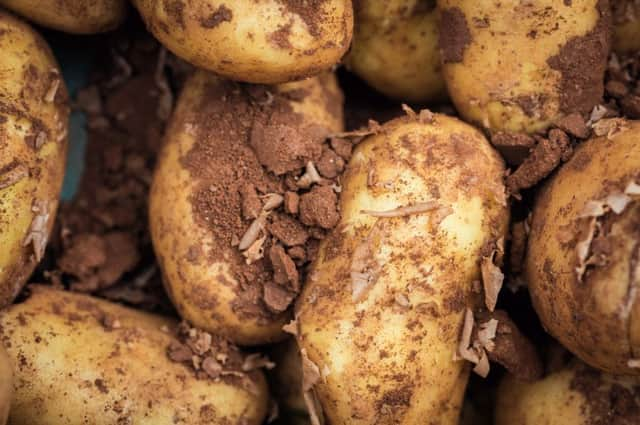When the chips are down...


While potatoes are generally pretty easy veg to grow given the right soil and situation, some gardeners end up with rotten, foetid tubers which will need disposing of as soon as they are out of the ground.
The most common problem is potato blight, a disease which causes brown or black patches to appear on young leaves from June onwards. The disease spreads rapidly to stems and finally the plant collapses. Spores are washed down to the tubers, resulting in a reddish brown rot and leaving the potatoes a soggy mass.
Advertisement
Hide AdAdvertisement
Hide AdIf you spot it early enough, you can remove infected leaves straight away to stop it spreading and ‘earth up’ or mulch rows with a thick layer of straw or hay.


Don’t harvest the crop for at least three weeks after removing the diseased foliage to allow time for the potato skins to thicken up and spores on the surface to die.
Don’t leave blighted tubers in the ground.
They will all need digging up as otherwise the spores will spread again, affecting subsequent crops.
Blight usually hits crops in warm, humid conditions from mid-summer onwards. It can be prevented by spraying with a copper-based fungicide, Bordeaux mixture, before symptoms first appear and repeating the treatment every two weeks.


Advertisement
Hide AdAdvertisement
Hide AdBut if blight has already appeared, no amount of fungicide will save your crop.
To reduce the risk of blight, practise crop rotation — don’t grow potatoes on the same piece of land more than once every four years — and use deep earthing up to protect the tubers.
Grow early potatoes, which are lifted before blight appears, or those which show some blight resistance, including ‘Sarpo Mira’, ‘Colleen’ and ‘Cosmos’. Make sure you always buy certified seed potatoes and don’t save your own tubers.
Other potato problems include blackleg, a bacterial disease that causes the leaves to wilt and the stems to blacken. This usually occurs early in the season and in dry weather. You’ll need to destroy affected plants.


Advertisement
Hide AdAdvertisement
Hide AdSlugs can be a major pain in heavy and wet soil, and there’s not a lot you can do about them unless you resort to slug pellets or other common slug deterrents. Early potato varieties may be less affected and if you lift your maincrops early you may be able to enjoy them before the slugs do.
The first sign of eelworms, tiny worm-like creatures which burrow into the roots of potatoes, is when plants growing close to each other start dying from the base upwards and the leaves yellow.
Tiny reddish brown cysts grow out from the roots, which are the females and full of eggs. Affected plants will soon die.
Scab is another common disease which is common in light soils, caused by a fungus, but although the skins may be damaged, the affected potatoes can be eaten after peeling. To help prevent it, add plenty of organic matter to the soil before planting and water regularly during a long, hot summer.


Advertisement
Hide AdAdvertisement
Hide AdFind out if there’s a Potato Day near you - many events are publicised online - organised by your local garden club or society, offering growers an ever-expanding choice, advice on dealing with pests and diseases and the chance to talk potatoes with fellow enthusiasts.
Events nationwide run through to March.
BEST OF THE BUNCH - Snowdrop (Galanthus)
It’s the pint-sized dazzler of late winter, marked by white carpet displays across the country and at various National Trust properties, parks and gardens.
If you have your own woodland area and you want a naturalised effect, you’ll have to plant a huge number of bulbs.
Perhaps the best approach is to build your snowdrop colony gradually, planting more clumps each year.


Advertisement
Hide AdAdvertisement
Hide AdPlant them in early autumn in groups of 10 or more, spacing them 4cm apart and 6-7cm deep.
They should reach their potential after a couple of years. They prefer semi shade and ideally a moist soil rich in organic matter.
Look out for Galanthus ‘S. Arnott’, which has large, fragrant flowers, and G. ‘Atkinsii’, a tall variety on long stems.
GOOD ENOUGH TO EAT - Preparing ground for grapes
You may think that growing grapes is only for those living in the Mediterranean, but if you have a sunny, sheltered, south-facing wall you could be growing vines and may even get some fruit out of them.
Advertisement
Hide AdAdvertisement
Hide AdPrepare the spot now for outdoor grapes by digging a large planting hole, around 1m (3ft) square and lining it with bricks.
This serves as an underground pocket which keeps the plants compact so they produce more fruit and less leafy growth. Fill it with good quality topsoil and add plenty of compost.
Leave it a few months until you plant a new vine. April is probably the best time and plant a pot-grown one, with the top of the rootball level with the soil surface, training the stems out over the wall and tie them to a trellis or wall nails.
Those main stems will thicken and produce sideshoots every year. Keep vines well watered in dry spells in the summer when they are carrying fruit. You will need patience. The vine will need a year or two to establish before producing grapes and initially it’s worth limiting each vine to four bunches, or fruit will be small. In midwinter, when the vine is dormant, thin out overcrowded growth. In spring, mulch generously and add fertiliser and some sulphate of potash over the soil at the base of each plant.